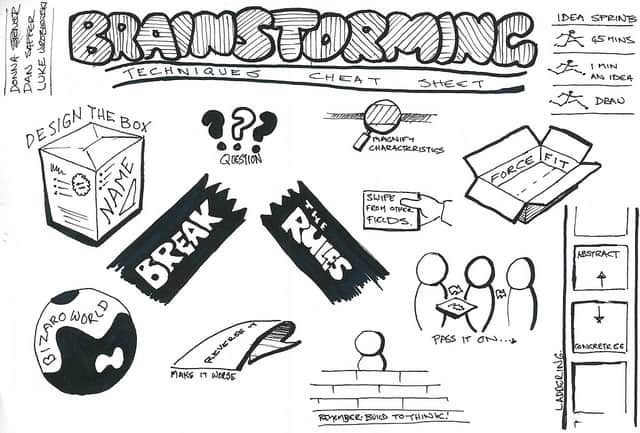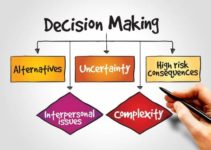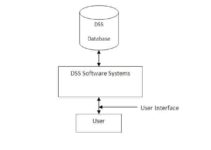Techniques of Group Decision Making
Some of the techniques employed to make the group decision-making process more effective and decision-making more efficient in which creativity is encouraged are as follows.
Brainstorming
Brainstorming technique involves a group of people, usually between five and ten, sitting around a table in a classroom setting generating ideas in the form of free association. The primary focus of the brainstorming technique is more on ‘generation of ideas’, rather than on ‘evaluation of ideas’, the idea being that if a large number of ideas can be generated, then it is likely that there will be a unique and creative solution among them.
All these ideas are written on the blackboard with a piece of chalk so that everybody can see every idea and try to improve upon them. The leader of the group defines and explains the nature of the problem to the group members and the rules to be followed.
(a) No judgements are to be made on these ideas when they are generated. No idea is to be criticized or evaluated in any way until all ideas have been considered.
(b) Welcome wild ideas, no matter how absurd they might seem. Some of the wildest ideas have resulted in unique solutions. There should be no inhibition in generating any ideas. The ideas that are too wild and unfeasible can always be discarded later.
(c) Strive for quantity and not quality. Quality can always be judged at the end. The more ideas there are, the better the chances that the best solution will not escape.
(d) Each participant is encouraged to improve or modify other participant’s suggestions. The system can make improvements on the ideas, not visualized by the participant who originally suggested them. This process results in free association and unrestricted thinking and may generate some novel idea which may not have been thought of originally.
Brainstorming technique is very effective when the problem is comparatively specific and be simply defined. A complex problem can be broken up into many parts and each part can be taken separately at a time. The process is very time consuming and it is quite possible that none of the ideas generated would be optimal.
But the process itself being democratic in nature creates a lot of interest among subordinates and stimulates their thinking. Also, the wasted time can be minimized if the members of the group are chosen carefully so that they understand the problem and feel that their contribution towards ideas generation will be substantial.
Delphi Technique
Delphi technique is a modification of brainstorming technique that it involves obtaining the opinions of experts physically separated from each other and unknown to each other. Generally, the problems handled by this technique are not specific in nature or related to a particular situation at a given time.
The process is more involved in predicting and assessing the impact on our society of nature events in a given area. For example, the Delphi technique may be used to understand the problems that could be created in the event of a war and after. Typically, a group of experts is assembled whose specialty lies in a given field and they are asked to give their opinions about a problem or situation that might develop.
For example, physicians would be used to get ideas on how to treat a particular disease such as AIDS and medical psychologists will be used to deal with family of a patient of terminal disease or who is in a coma. All these opinions are handled by a central coordinator, who consolidates these opinions and this summarized information is sent back to the experts again for further analysis and opinion refinement. The following sequential steps characterize the technique
(a) The problem is identified and set of questions is built relating to the problem so that the answer to these questions generates solutions to the problem. These questions are consolidated in the form of a questionnaire.
b) Experts in the problem area are identified and contacted. The questionnaire is sent to each member who anonymously and independently answers the questions and sends it back to the central coordinator.
c) Once received, the results of this questionnaire are compiled and analyzed and on the basis of the responses received, a second questionnaire is developed which is mailed back to the participating members.
d) The members are asked again to react to these responses and to comment, suggest, evaluate and answer the new questions, possibly generating some new ideas and solutions.
e) The responses to this second questionnaire are compiled and analyzed by the central coordinator and if a consensus has not been reached, then a third questionnaire is developed, pinpointing the issue and unresolved areas of concern.
f) The above process is repeated until a consensus is obtained. Then final report is prepared and a solution is defined and developed if possible
One of the main advantages of the Delphi technique is that the group members are totally independent and are not influenced by the opinion of other members. It is an efficient method of poling a large number of experts’. Judgements and the members do not have to be present at one location, this means that an expert who is geographically separated can also contribute his thoughts and opinions so that the cost associated with bringing these experts together is avoided. Also, the process avoids the problem of conformity and domination that often occurs in interacting groups.
The main disadvantage of this technique is that it is highly time consuming and is primarily useful in illuminating broad range, long term complex issues such as future effects of energy shortages that might occur. This technique also eliminates the sense of motivation that arises in a face to face interacting group.
Nominal Technique
The Nominal Technique is very similar to Brainstorming but is considered to be more effective. This may be due to highly structured procedures employed for generating and analyzing various ideas and alternatives. It may be physically domination is avoided.
The process is similar-to a traditional committee meeting expect that the members operate independently, generating ideas for solving the problem in silence and in writing. The group leader or the coordinator either collects these written ideas or writes them on a large blackboard as he received it. These are then discussed one by one, in turn, and each participant is encouraged to comment on these ideas for the purpose of clarification.
After all ideas are discussed and clarified, they are evaluated for their merits and drawbacks and each participating member is required to vote on each idea and assign it a rank on the basis of priority of each alternative solution. The idea with the highest aggregate ranking creates an atmosphere of creativity because participants often work hard to generate ideas in the presence of others.
Fishbowling
Fishbowling is another variation of the brainstorming but is more structured and is to the point. In this technique, the decision-making group of experts is seated around a circle with a single chair in the center of the circle. One member of the group or the group leader is invited to sit in the center chair and give his view about the problem and his proposition of a solution.
The other group members can ask him questions but there is no irrelevant discussion or cross talk. Once the member in the center chair has finished talking and his viewpoint is fully understood, he leaves the center and joins the group in the circle. Then the second member is called upon to sit in the center chair and give his views in the light of the views expressed earlier.
The members can ask questions to the center based upon the new ideas presented by the member. In the center as well as the ideas discussed by previous center members continuous until the chair is vacated. All exchanges must be between the center and the group and no two group members are allowed to talk directly.
This technique result in each member favoring a particular course of action, since all members are acting upon the database and also since each idea offered by the central members has been thoroughly questioned and examined. After all experts have expressed their views, the entire groups discuss the various alternatives suggested and pick the one with consensus.
Didactic Interaction
Didactic interaction is applicable only in certain situations, but is an excellent method when such a situation. For example, the decision may be to buy or not to buy, to situation requires an extensive and exhaustive discussion and investigation since a wrong decision can have serious consequences of either of the two alternatives, the group required to make the decision is split into two subgroups, one favoring the ‘go’ decision and other favoring the ‘no go’ decision. The first group lists all the ‘pros’ of the problem solution and the second group lists all the ‘cons’.
These two groups meet and discuss their findings and their reason. After the exhaustive discussions, the group switch ideas and try to find weakness in their own original viewpoints. This interchange of ideas and tolerance and understanding of opposite viewpoint results in mutual acceptance of facts as facts as they exist so that a solution can be built around these facts and thus a final decision is reached.




